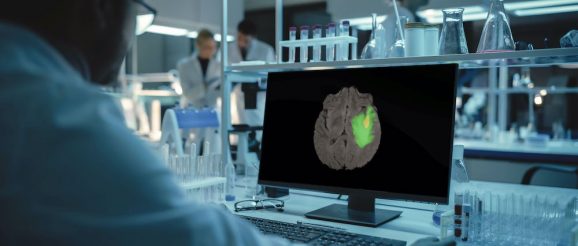Medical image segmentation: Transforming healthcare in 2022 – Med-Tech Innovation

Medical Research Scientist Working on Desktop Computer with Virus Analysis Software in Modern Science Research Laboratory. Lab Engineers in White Coats Conduct Experiments in the Background.
2022 marks another new year and era for digital transformation within healthcare. After undergoing huge changes because of the pandemic in the last two years, the future of the healthcare industry is predicted to see new innovations and technologies for years to come. Medical image segmentation is predicted to advance like never before in 2022, becoming a turning point in daily clinical practice thanks to artificial intelligence (AI).
What is medical image segmentation?
Medical image segmentation involves the extraction of regions of interest (ROIs) from image data, for example from Magnetic Resonance Imaging (MRI) or Computed Tomography (CT) scans. The main goal of segmenting this data is to identify areas of the anatomy required for a particular study or further analysis, such as, to simulate physical properties or virtually positioning CAD-designed implants within a patient. As a result, manual medical image segmentation is a time-consuming task. However, recent advances in AI software are making it easier for routine tasks like this to be completed quickly without compromising on quality.
Accelerated by artificial intelligence
The health sector has witnessed an unprecedented level of success and breakthroughs achieved by AI-powered techniques in countless fields of science and industry, with medical image analysis very much included. With the availability of high-performance hardware and a variety of software tools, the recent advances in classical machine learning and deep learning mean it has become easier than ever before to deploy in clinical settings.
However, we have only just scraped the surface of what can be achieved when implementing AI. There are many tasks and processes that remain an opportunity to be effectively automated using data-driven algorithms. From improving the clinical workflow through automating scheduling and operations, to enhancing the quality of medical images, their registration, segmentation, and classification, the process of transforming image data into mineable and quantifiable features allows users to build diagnostic or predictive AI models and empowers the data-driven decisions.
Specialised AI algorithms can be applied in the process of drug development, especially when it comes to oncology. The technology is also being used to analyse different organs from different types of studies such as CT, MRI, and PET It has become possible to extract new biomarkers from medical images, correlates myriads of features to find patterns that would be unobtainable through conventional means. Ultimately, machine learning experts are now able to create cutting-edge solutions for medical image segmentation and analysis using deep learning.
Benefits of medical image analysis in practice
Medical image analysis is undoubtedly one of the most important procedures performed by radiologists and medical physicists. Accurate depiction of abnormal tissue is key in defining the treatment pathway or drug discovery trajectory, as it enables professionals to quantify and monitor the treatment’s efficiency and patient’s response.
As a direct example, let’s assume that we want to understand the volumetric characteristics of a brain tumour in a longitudinal study. In this study, a patient was repeatedly scanned, and several MRI scans were manually reviewed by a human reader. In the perfect world, an observed decrease of the tumour volume captured would mean that things are going well, but this decrease can easily be a result of poor reproducibility and intra-rater variability, inherently related to manual image analysis.
This is where AI comes into play. As a robust software tool that can automatically deliver, in a fully reproducible way, AI can analyse and provide objective, repeatable measurements of the regions of interest instantly with little to no room for error.
The future of medical image segmentation
AI algorithms help us to not only build automated pipelines for the most time-consuming tasks, such as medical image segmentation, but they can also help healthcare professionals see beyond the visible through extracting features that are impossible to be seen by humans on their own. However, these tools must be thoroughly verified and validated on large, unbiased sets of data to make them appropriate in clinics, as their results can have significant repercussions. Therefore, having an adequate deep model is a great initial step with follow up actions to include designing and implementing theoretical and experimental validation of the pivotal elements of the processing pipeline in a fully reproducible, quantifiable, and thorough way that is evidence-based.
